Warplanes of the USA: Ohio, Dayton, National Museum of the USAF: North American
Dayton, National Museum of the United States Air Force (NMUSAF), 1100 Spaatz St., Wright-Patterson AFB, 45433-7102.
North American
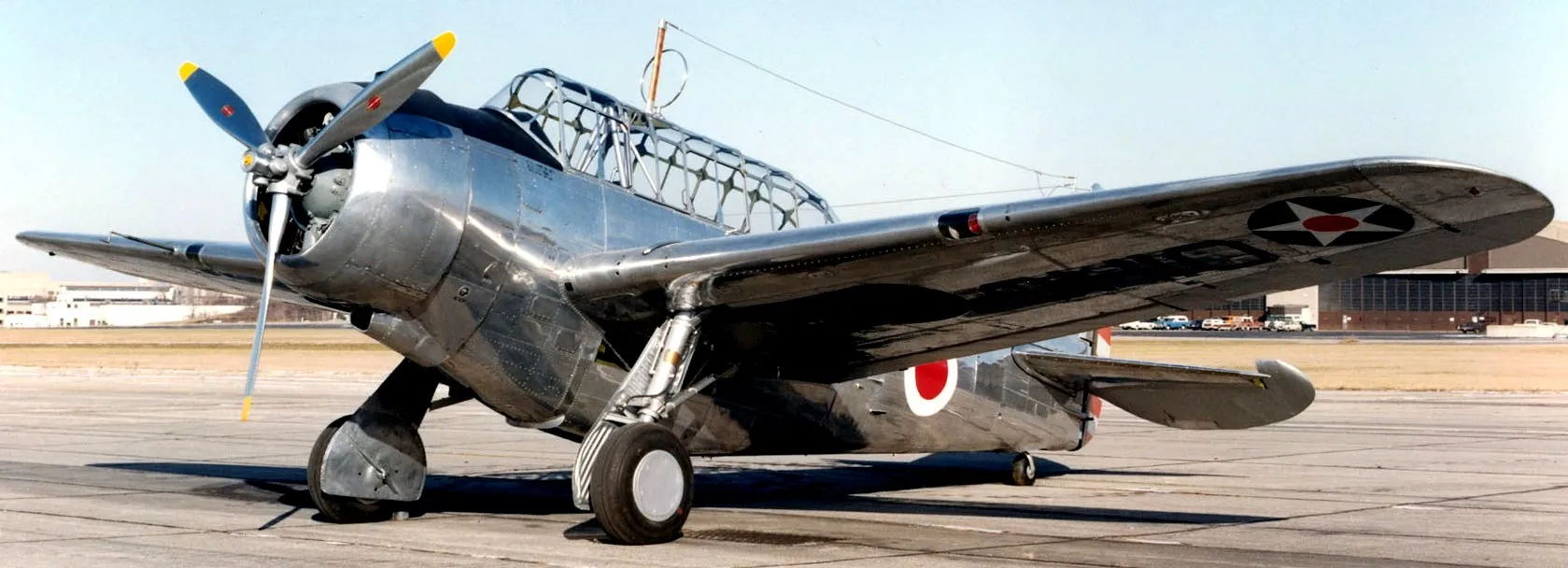


(NMUSAF Photos)
North American O-47B (Serial No. 39-112). The NMUSAF acquired the O-47B on display in 1978 from Loren L. Florey Jr., of Eden Prairie, Minnisota. The 179th Consolidated Aircraft Maintenance Squadron, Ohio Air National Guard, Mansfield, Ohio, restored the aircraft in the markings of an O-47A of the 112th Observation Squadron of the Ohio National Guard.

(BT-9A at Langley, NASA Photo)
North American BT-9B Yale (Serial No. TBC).
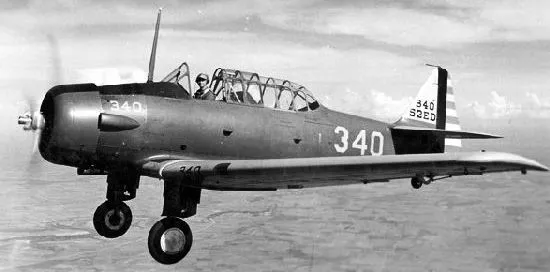
(USAF Photo)

(NMUSAF Photo)
North American BT-14 (Serial No. 737). Ex-RCAF North American NA-64 Yale painted to represent a USAAC BT-14, in a diorama. Very similar to the BT-14, this North American NA-64 is one of a group of aircraft originally built for the French. When Germany defeated France in 1940, undelivered NA-64s were diverted to the Royal Canadian Air Force where they served as Yale I flight and radio operator trainers. In 1974 the aircraft on display was extensively restored, after which it flew in air shows and conducted aerial photography. In 1978 Challenge Publications Inc. (Air Classics, Air Combat, Air Progress), Mr. Edwin Schnepf, president, donated it to the National Museum of the United States Air Force.




(NMUSAF Photos)
North American T-6D Mosquito (Serial No. 42-84216), TA-216, C/N 88-15997. The T-6D on display in the NMUSAF flew as an early Mosquito with the 6147th Tactical Air Control Group during the first two years of the Korean War. Ironically, it was converted to a mosquito spraying aircraft in 1952. Two years later, the USAF transferred it to the fledgling Republic of Korea Air Force (ROKAF). After retiring this aircraft, the ROKAF placed it on display outside for several years. The National Museum of the United States Air Force acquired it in 1995, and after restoration it went on display in 2001.
North American T-6G Texan (Serial No. 50-1279), painted as (Serial No. 41279).


(NMUSAF Photos)
North American B-25B Mitchell (Serial No. 43-3374). The airplane on display was built as an RB-25D. It was removed from storage at Tucson, Arizona, and rebuilt by North American Aviation at Inglewood, California, to the configuration of the lead B-25B flown by Lt. Col. Doolittle on the Tokyo Raid. It was then flown to the museum, arriving in April 1958.

(USAAF Photo)
North American A-36A Apache. The North American A-36 (company designation NA-97, listed in some sources as "Apache" or "Invader", but generally called Mustang) was the ground-attack/dive bomber version of the North American P-51 Mustang, from which it could be distinguished by the presence of rectangular, slatted dive brakes above and below the wings. A total of 500 A-36 dive bombers served in the Mediterranean and Southeast Asia theaters during the Second World War before being withdrawn from operational use in 1944. The A-36 project was a stopgap measure intended to keep North American Aviation (NAA) assembly lines running during the first half of 1942 despite the US having exhausted its funds earmarked for fighter aircraft. When the order came for more P-51s in June 1942, the NAA workforce was thoroughly experienced. (Wikipedia)



(NMUSAF Photos)

(Valder137 Photo)

(Goshimini Photo)

(Martin McGuire Photo)
North American A-36A Apache (Serial No. 42-83665), C/N 97-15883. The NMUSAF’s A-36A was donated by Charles P. Doyle of Rosemount, Minnesota and was restored by members of the Minnesota Air National Guard. It is marked to represent the A-36A flown by Capt Lawrence Dye, a pilot of the 522nd Fighter-Bomber Squadron, during combat in North Africa and Italy.





(NMUSAF Photos)

(Valder137 Photo)

(Goshimini Photo)
North American P-51D Mustang (Serial No. 44-74936), 52, C/N 122-41476, "Shimmy IV". The NMUSAF P-51D on display was the last Mustang assigned to a USAF tactical unit. It is painted as P-51D (Serial No.44-15174), as flown by Col C.L. Sluder, Commander of the 325th Fighter Group, 15th Air Force in North Africa and Italy in 1944. The name of this aircraft, Shimmy IV, is derived from the names of his daughter, Sharon, and his wife, Zimmy.
On 27 January 1957, this was the final P-51D retired from USAF service.




(NMUSAF Photos)
North American F-82B Twin Mustang (Serial No. 44-65168), C/N 123-43754. “Betty Joe”. The F-82 was the last propeller-driven fighter acquired in quantity by the USAF. The Twin Mustang carried a pilot and co-pilot/navigator to reduce fatigue on long-range bomber escort missions. It was produced in time to take part in the Second World War, but after the war, Air Defense Command flew radar-equipped F-82Gs as replacements for the P-61 night fighter. During the Korean War, Japan-based F-82Gs were among the first USAF aircraft to operate over Korea. On 27 June 1950, all-weather F-82Gs shot down the first three North Korean airplanes destroyed by U.S. forces. Of a total of 273 F-82s produced, 20 were F-82Bs. The F-82B on display, Betty-Jo, flew from Hawaii to New York on 27-28 Feb 1947, a distance of 5,051 miles, the longest non-stop flight ever made by a propeller-driven fighter. Betty-Jo came to the NMUSAF in 1957.
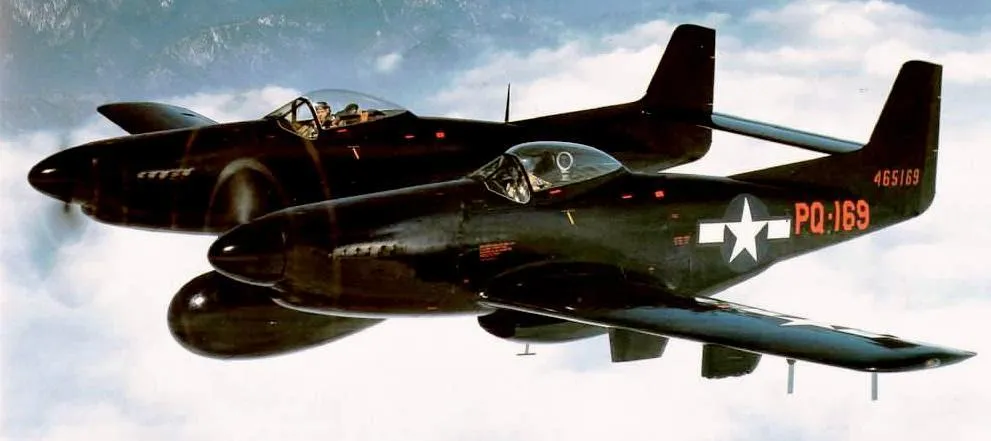
(USAF Photo)

(NMUSAF Photo)
North American F-82B Twin Mustang (Serial No. 44-65162), C/N 123-43748. The aircraft on display in the NMUSAF is an F-82B, modified and marked as the F-82G crewed by Lts. Charles Moran, pilot, and Fred Larkins, radar observer, 68th F(AW)S, when they shot down a North Korean La-7 on 27 June 1950, near Kimpo Air Base, South Korea.



(NMUSAF Photos)
North American/Ryan L-17A Navion (Serial No. 47-1347), painted as 8928. All L-17s were re-designated U-18s in 1962. The L-17A on display was flown to the museum on 7 April 1986. It is marked as a Ryan-built L-17B used by the Air Force ROTC program at Bradley University, Peoria, Illinois, in the spring of 1959.


(NMUSAF Photos)
North American F-86A Sabre (Serial No. 49-1067), C/N 161-61, painted as (Serial No. 49-1236). The F-86A on display in the NMUSAF was flown to the museum in 1961. It is marked as the 4th Fighter Group F-86A flown by LCol Bruce Hinton on 17 Dec 1950, when he became the first F-86 pilot to shoot down a MiG.


(NMUSAF Photos)
North American RF-86F Sabre (Serial No. 52-4492), previously located at Bergstrom AFB, Texas. The Sabre, originally built as a day fighter, was first modified for reconnaissance during the Korean War. USAF personnel custom-fitted cameras to about a dozen F-86 fighters (known as "Honeybuckets" or "Ashtrays") to replace the slower RF-80 for missions in northwestern North Korea, "MiG Alley", and into Manchuria. After the Korean War, a handful of F-86Fs received more capable cameras under Project Haymaker. In order to fit the film magazines for the vertically mounted cameras, the aircraft acquired a distinctive bulge on both sides of the forward fuselage. The armament was removed to allow for the cameras, and the RF-86F "Haymakers" had painted-on gun ports to appear as if they were armed. In March 1954 the 15th Tactical Reconnaissance Squadron deployed to Komaki Air Base, Japan, receiving eight newly-modified "Haymakers." With these aircraft, they secretly overflew Soviet, North Korean and communist Chinese territory in the mid-1950s. The RF-86F "Haymaker" on display in the NMUSAF participated in these critical overflight missions. It was transferred to the South Korean air force (ROKAF) in 1958, which flew it into the 1980s. Arriving at the museum in 1998 for restoration, it was placed on display in 2005. It is marked as it appeared while assigned to the 15th Tactical Reconnaissance Squadron.


(NMUSAF Photo)

(Clemens Vasters Photo)
North American F-86D Sabre Dog (Serial No. 50-0477), FU-863, C/N 165-23, painted as (Serial No. 52-3863). The aircraft on display in the NMUSAF came to the museum in August 1957. It is marked as an F-86D assigned to the 97th Fighter Interceptor Squadron at Wright-Patterson Air Force Base, Ohio, during the mid-1950s.

(NMUSAF Photos)
North American F-86H Sabre (Serial No. 53-1352), C/N 203-124. Cutaway. The NMUSAF obtained the F-86H on display from the New Jersey Air National Guard in November 1964. It is exhibited with part of its stressed skin removed to show the internal structure and placement of equipment.
North American F-100C Super Sabre (Serial No. 54-1753)



(NMUSAF Photos)
North American F-100D Super Sabre (Serial No. 55-3754), 6, C/N 223-436, Thunderbirds markings. The aircraft on display in the NMUSAF was used by the Thunderbirds, the official USAF Flight Demonstration Team, from 1964 until 1968. During that period, the team toured the Caribbean, Europe, Latin America and nearly every state in the United States. This F-100D was retired from service with the 114th Tactical Fighter Group, South Dakota Air National Guard, in 1977. It was restored by Thunderbird maintenance personnel at Nellis Air Force Base, Nevada, to its original appearance as a team aircraft. It was flown to the museum by the Air National Guard, and the Thunderbirds presented the aircraft to the museum on 22 July 1977.





(NMUSAF Photos)

(Dsdugan Photo)
North American F-100F Super Sabre (Serial No. 56-3837), HE, C/N 243-113. When F-100 units deployed to Southeast Asia, they included a mix of one- and two-seat F-100s, and both types participated in traditional bombing missions in support of ground forces. As tactics developed, the two-seat F-100F became an important aircraft for two new missions, surface to air missile (SAM) suppression, known as "Iron Hand," and high-speed forward air control (FAC), known as "Misty FAC." The aircraft on display in the NMUSAF was a Misty FAC aircraft assigned to the 37th Tactical Fighter Wing at Phu Cat Air Base, Vietnam. It was flown in combat by several notable USAF figures, including Gen Merrill McPeak and Gen Ronald Fogleman (former USAF chiefs of staff), and Col Richard Rutan (the chief pilot of the first around-the-world unrefueled flight). It is painted as it appeared in March 1968, and went on display in 2003.

(USAF Photo)
North American RB-45C Tornado (Serial No. 48-037).

(USAF Photo)
North American B-45C Tornado.



(NMUSAF Photo)

(Martin McGuire Photo)
North American B-45C Tornado (Serial No. 48-0010), 10, C/N 153-38486. The aircraft on display in the NMUSAF was returned to the USAF by Pratt & Whitney Aircraft Division, where it had been on loan for engine testing. It was flown to the museum in 1971, and is painted in the markings of the 47th Bomb Wing (Light).
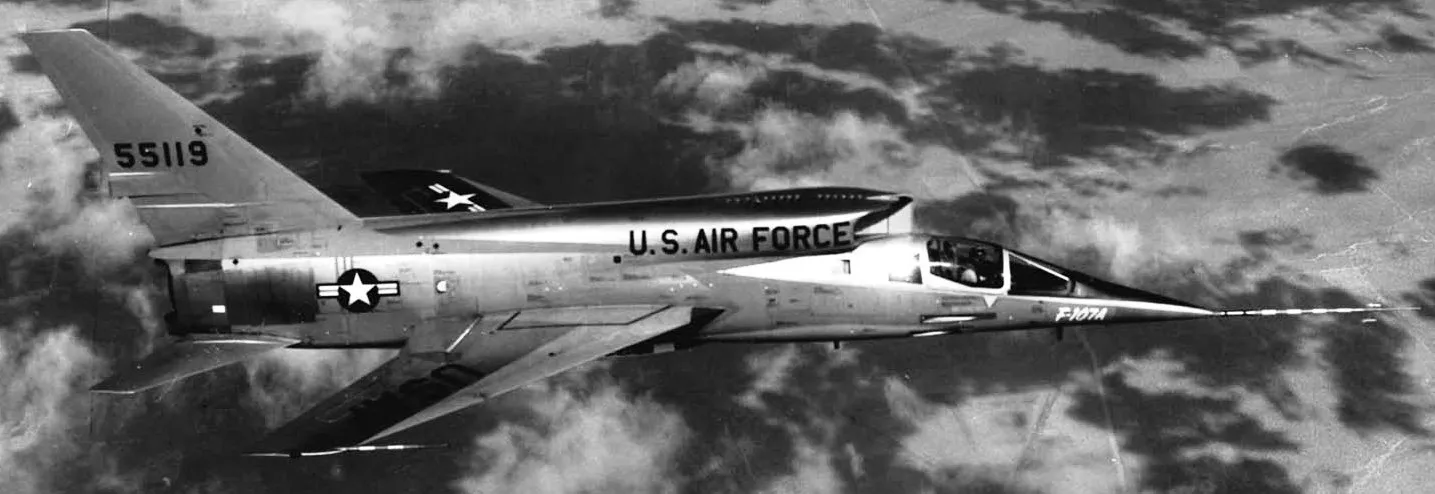



(NMUSAF Photos)
North American YF-107A (Serial No. 55-5119), C/N 212-2. The F-107A was a mid-1950s development of the successful F-100 Super Sabre . Special features of the F-107A included an engine air intake above the cockpit, an all-moving vertical fin, and a system (called a Variable Area Inlet Duct) that automatically controlled the amount of air fed to the jet engine. The first of three prototype F-107As flew in September 1956, attaining Mach 1 (Mach 1 is the speed of sound). A few months later, an F-107 flew at Mach 2 (twice the speed of sound). The following year, after seriously considering the production of the F-107, the USAF instead chose to buy the F-105 Thunderchief. The first and third F-107A prototypes were then leased to the NACA (National Advisory Committee for Aeronautics), predecessor to NASA (National Aeronautics and Space Administration), for high-speed flight research. The F-107A on display in the NMUSAF is the second prototype, which was used for weapons testing with both conventional and atomic bombs. It was flown to the museum when the program ended in 1957.


(NMUSAF Photos)
North American X-10 (Serial No. 51-9307), C/N GM19307.

(USAF Photo)

(USAF Photo)
X-15 attached to its B-52 mother ship with a T-38 Talon escort.

(USAF Photo)


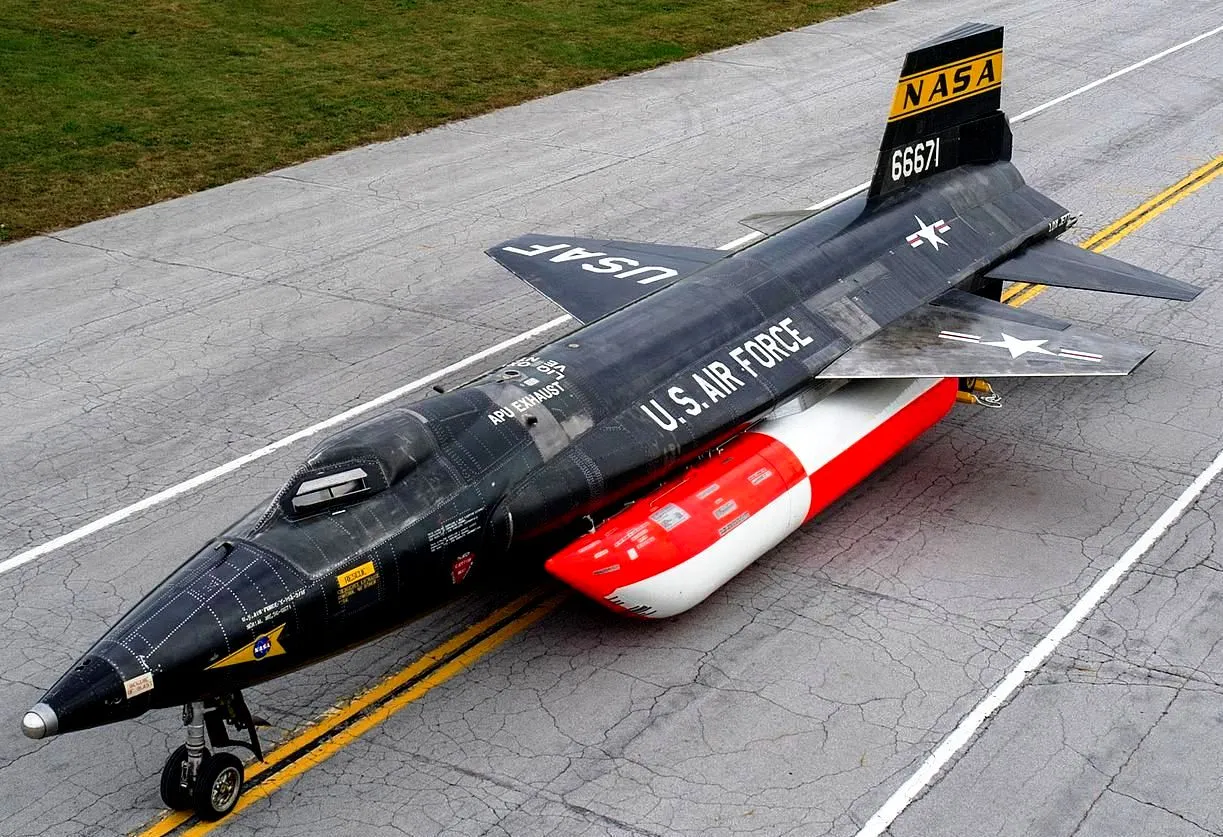
(NMUSAF Photos)

(Dsdugan Photo)
North American X-15A-2 (Serial No. 56-6671), C/N 240-2.











(NMUSAF Photos)
North American XB-70A Valkyrie (Serial No. 62-0001), C/N 278-1. The futuristic XB-70A was originally conceived in the 1950s as a high-altitude, nuclear strike bomber that could fly at Mach 3 (three times the speed of sound). At that time, any potential enemy would have been unable to defend against such a bomber. By the early 1960s, however, new Surface-to-Air Missiles (SAMs) threatened the survivability of high-speed, high-altitude bombers. Less costly, nuclear-armed ICBMs (Intercontinental Ballistic Missiles) were also entering service. As a result, in 1961, the expensive B-70 bomber program was canceled before any Valkyries had been completed or flown. Even so, the USAF bought two XB-70As to test aerodynamics, propulsion and other characteristics of large supersonic aircraft. The first XB-70A, on display in the NMUSAF, flew in September 1964, and it achieved Mach 3 flight in October 1965. The second Valkyrie first flew in July 1965, but in June 1966, it was destroyed following an accidental mid-air collision. The third Valkyrie was not completed. The first XB-70A airplane continued to fly and generate valuable test data in the research program until it came to the museum in 1969.



(NMUSAF Photos)
North American T-28A Trojan (Serial No. 49-1494). The T-28A on display in the NMUSAF is painted as a typical Air Training Command T-28A in the mid-1950s and was transferred to the museum in September 1965.


(NMUSAF Photos)
North American T-28B Trojan (BuNo. 140048), painted as 38365. The T-28B on display in the NMUSAF is painted as a VNAF T-28B assigned to Bien Hoa Air Base in 1962, where USAF pilots trained and flew combat missions with VNAF crews in Operation Farm Gate. It was flown to the museum in March 1987.

(NMUSAF Photo)
North American T-39A Sabreliner (Serial No. 62-4478), C/N 276-31.

(Valder137 Photo)



(NMUSAF Photos)
North American Rockwell OV-10A Bronco (Serial No. 68-3787), C/N 321-113. The first USAF OV-10As destined for combat arrived in Vietnam in July 1968. A total of 157 OV-10As were delivered to the USAF before production ended in April 1969. The aircraft on display in the NMUSAF came to the museum in October 1991 and is painted as it appeared when it served in Southeast Asia.





